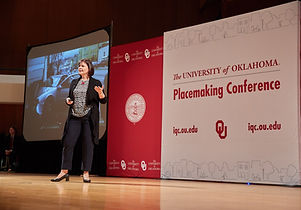
Open to the Public sought to create a foundation for security conversations with government and nonprofit leaders responsible for the design and management of public spaces.

Susan Silberberg highlighted the cumulative security interventions that have become “white noise” in our urban environment.

Susan Silberberg’s long-term security and public space research offered a framework for a path forward when considering a balance of safety and civic vibrancy.

Open to the Public sought to create a foundation for security conversations with government and nonprofit leaders responsible for the design and management of public spaces.
OPEN TO THE PUBLIC
Rethinking security and access in public space
In the Fall of 2019, CivicMoxie’s Susan Silberberg was a keynote speaker and panelist at a symposium hosted by the National Capital Planning Commission at the Naval Heritage Center Burke Theater at the US Navy Memorial In Washington, DC. The event, which also included the Federal Protective Service’s Kris Cline, and Reed Hilderbrand’s Gary Hilderbrand, and moderated by Jess Zimbabwe of Plot Strategies, explored the issues and potential solutions of security and public space design.
The speakers’ highlighted the current state of security in the public realm and discussed methods to better balance safety and accessibility. Susan Silberberg opened the discussion by describing public spaces as places where people come together as a democratic society and referred to half a century worth of important research1 on what makes public spaces successful. Drawing on her long-term research of public spaces pre- and post-9/11, she commented that, “Places that are neither home nor work. Places that are the core of ‘civitas’ – where there is free and unfettered access and an exchange of cultures and ideas. Where people play, rest, contemplate, meet and greet, and build relationships.”
Through a case study example of Boston’s Financial District, she outlined important considerations in public space security design, including clearly articulating threats, understanding key stakeholders’ motivations, and measuring the cumulative effect of security interventions on public space, circulation, and civic life. Susan discussed design typologies as they would apply to Washington’s urban spaces, such as neighborhood public parks, public or private building plazas, streets used as public spaces, and large urban parks that accommodate big events. She stressed that all public space security improvements should:
-
Improve aesthetic quality and how the public space is used;
-
Require a coordinated and rigorous threat assessment and application of best practices;
-
Need a careful plan for creating pedestrian-only places and other areas with restricted vehicular access;
-
Benefit from security “ambassadors” (such as Business Improvement District staff);
-
Incorporate public art and amenities that engage the occupants, encouraging greater awareness of surroundings.
The event, along with a next-day invitation-only workshop for decision-makers in public space design and management resulted in a report includes “Ten Big Ideas for Rethinking Security in Public Space.”
Project type:
Corridor / main streets, downtown / district plan, placemaking, speaking / innovation, urban design



